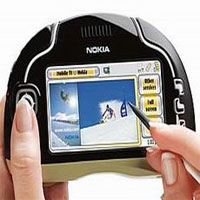- About Us
- Columns
- Letters
- Cartoons
- The Udder Limits
- Archives
- Ezy Reading Archive
- 2024 Cud Archives
- 2023 Cud Archives
- 2022 Cud Archives
- 2021 Cud Archives
- 2020 Cud Archives
- 2015-2019
- 2010-2014
- 2004-2009
 |
Short Form Digital Content: The Demise of TV Dinners |

What would Sergio Leone think of all this? How can you have sweeping vistas and bold wideshots when your screen is no bigger than a beer coaster? Is that any way to tell a story?
Apparently so. And in less time than it takes to say “once upon a time in the west.” We are getting up from the couch and thanks to Tivo when we sit back down it is on our own time. Today’s viewers are no longer tied to television schedules. Hey, let’s face it; they are no longer tied to television.
This is most true for the younger demographic. MTV and other youth-oriented programming continue to lose eyeballs to online video, especially YouTube and MySpace –which is technically the biggest online video site in the world. And these changes in technology and user behavior are giving rise to a new category of storytelling: Short Form Digital Content.
To earn the capital letters in its name, Short Form Digital Content needs to be short –typically three to eight minutes; Digital –shot with an understanding of the medium and the restrictions surrounding how it will be used; and it must have a mobile strategy –either it will be delivered via portable media devices or it has the capability to do so.
USA Today dates the beginning of this new category to 2001 when a serialized graphic novel, Broken Saints, appeared on the internet. It attracted 5 million viewers for its 24 episode run –enough to convince 20th Century Fox to release it on DVD. 2001 seems as good a year as any to mark the beginning of Short Form Digital Content. While there were short video narratives around before that date, many of them fell into that ubiquitous waste of time, money and cask wine: The amateur short film. And they certainly weren’t available via mobile (thank God).
But 2006 will be known as the year when producers finally stepped up to the plate. Online video sharing is now the single biggest distribution method for moving pictures ever created –even before we factor in the potential of handheld media devices. Already there are original series; call them ‘webisodes’, call them ‘mobisodes’; appearing on video sharing sites.
Launched in May, Soup of The Day (www.zabberbox.com) follows Brandon as he tries to select which of his three girlfriends he wants to be with. Six million views. And users could vote to influence which one he chose. Floaters (www.phoebeworks.com): three sexy single girls temp at a New York advertising agency. I would rather watch terrorist ransom videos than something like this but there is definitely a market for it –especially when you consider that females are typically more likely than males to use their cellphone for things other than talking. This could prove popular should it move to mobile.
 In Australia the mobisode evolution is in full swing. The Australian Broadcasting Corporation (ABC) makes available highlights from Rage –its music video program. The ABC also repackages content from The Chaser for mobile. A comedy drama series, Forget The Rules (www.forgettherules.com) was distributed via the internet and one of Australia’s 3G networks. Quoted in Inside Film magazine, Forget The Rules producer, Jim Shomos, who is seeking funding for a second series, says “Nobody wants to fund production, and the carriers don’t want to deal with individual suppliers. They would rather come through and aggregator than to do a deal direct.”
In Australia the mobisode evolution is in full swing. The Australian Broadcasting Corporation (ABC) makes available highlights from Rage –its music video program. The ABC also repackages content from The Chaser for mobile. A comedy drama series, Forget The Rules (www.forgettherules.com) was distributed via the internet and one of Australia’s 3G networks. Quoted in Inside Film magazine, Forget The Rules producer, Jim Shomos, who is seeking funding for a second series, says “Nobody wants to fund production, and the carriers don’t want to deal with individual suppliers. They would rather come through and aggregator than to do a deal direct.”
Any independent producer would feel his pitching pain but the statement is only partially correct. Optus, another Australian mobile carrier has commissioned its own drama series that will be aired on both pay-TV and mobile. In the UK, 3 Network is offering ₤50 000 for three minute pilots. And let’s not forget my own bread and butter: Advertising.
In September Warner Bros announced the creation of Studio 2.0; dedicated to the creation of advertiser funded short form content. If mobile carriers are reluctant to enter this market advertisers certainly aren’t. Studio 2.0 was formed as a production company for ‘advertainment’: narrative content based around or sponsored by a client’s brand. In my opinion this will be the key to the rapid growth of Short Form Digital Content –just like it was for the emergence of every other new medium. Sponsored content that can reach a highly targeted demographic wherever they happen to be in the cell-covered world, the delivery of an advertiser’s brand message straight to their own consumers’ mobile phones… there wouldn’t be a half decent agency anywhere in the world that would turn that down. And from the limited research done in the area, this is an audience that is particularly interested in advertising messages as long as they are contextual. The cell phone screen is an intensely private place for the user. The message had better be relevant.
 As an indication of just how big this market is expected to be, consider this: Nokia and Motorola have agreed to cooperate on mobile interoperability. It is anticipated that there will be 50 million DVB-H (Digital Video Broadband –Handheld) devices globally by 2010. Both companies will work together to support DVB-IPDC standards so that Short Form Digital Content will be available on handsets from either company. Neither Nokia nor Motorola wants to be left at the station when this train departs. The only big player left get on board is Sony Ericsson and considering that this is a Sony company they will likely try and ‘pioneer’ their own proprietary format. (Is anyone else stuck with a bunch of pointless memory sticks?)
As an indication of just how big this market is expected to be, consider this: Nokia and Motorola have agreed to cooperate on mobile interoperability. It is anticipated that there will be 50 million DVB-H (Digital Video Broadband –Handheld) devices globally by 2010. Both companies will work together to support DVB-IPDC standards so that Short Form Digital Content will be available on handsets from either company. Neither Nokia nor Motorola wants to be left at the station when this train departs. The only big player left get on board is Sony Ericsson and considering that this is a Sony company they will likely try and ‘pioneer’ their own proprietary format. (Is anyone else stuck with a bunch of pointless memory sticks?)
If one were to consult a crystal ball regarding the next few years of Short Form Digital Content this is likely what they will see:
- An independent producer creates a ‘made for YouTube’ series that becomes a runaway success. They appear on Larry King, get a contract with a studio/mobile carrier and vanish for a couple of years before bringing out a lukewarm variant of what made them successful in the first place.
- TV Networks begin to extend the brands of their shows by making additional content available exclusively for mobile. This will likely begin with extra ‘hilarious’/appalling auditions for American Idol. Then onto ‘essential’ extra information for really, really annoying shows like Lost that permanently leave viewers in the dark but manage to awaken the gambling instinct in all of us and keep us rabidly addicted to a show where having nothing happen in an entire episode is dressed up as ‘being mysterious’. Finally it will come to rest by fleshing out the B and C storylines of narrative dramas –the stuff that is cut to get an episode down under an hour but is actually of interest and value to a viewer.
- Mobile carriers –who know how to run a lean business in a competitive market- will quickly realize that they can save money by cutting out the networks (a meth-addicted Vegas chimp does not waste as much money as a television network) and go directly to advertising agencies and independent producers to create their own original content.
Number three is of most interest, I think. Let us not forget that this is a whole new medium. Four minute blocks are not a lot of time to tell a story. Heavy restrictions often lead to the most creative responses and we may just be on course for some really exciting new storytelling. And if not, it is still not so bad. There are rarely more than three decent jokes in a sitcom episode, anyway.
Think of the time you’ll save.
G Preston White is a New Zealand-based freelance writer. Visit his blog at http://newzealandmedia.blogspot.com or he can be contacted via his website http://www.prestonwhite.co.nz
